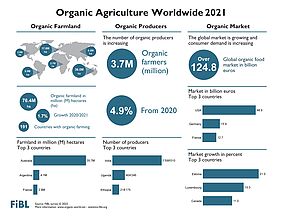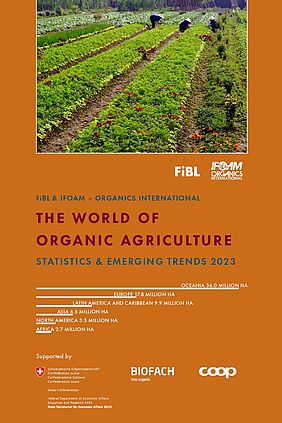(Frick, February 14, 2023) Organic farmland and retail sales both continued to show growth worldwide, according to data from 191 countries (data as of the end of 2021). Published by FiBL and IFOAM – Organics International, the 24th edition of "The World of Organic Agriculture" shows the trend of overall growth seen in past years continued into 2021, although at a slower pace.
This annual survey on global organic agriculture is supported by the Swiss State Secretariat for Economic Affairs (SECO), the Sustainability Fund of Coop Switzerland, and NürnbergMesse, organisers of the BIOFACH trade fair.
The global organic market continued to grow, but slower
In 2021, the organic market reached almost 125 billion euros – an increase of nearly 4 billion euros or approximately 3 percent.
With 48.6 billion euros, the United States continued to be the world’s leading market, followed by Germany (15.9 billion euros) and France (12.7 billion euros). Swiss consumers spent the most on organic food (425 euros per capita on average), and Denmark continued to have the highest organic market share, with 13 percent of its total food market.
3.7 million organic producers worldwide
In 2021, 3.7 million organic producers were reported, an increase of 4.9 percent compared to 2020. India remained the country with the most organic producers (1.6 million).
Steady increase of organic farmland
A bit more than 76.4 million hectares were organically managed at the end of 2021, representing a growth of 1.7 percent or 1.3 million hectares compared to 2020. Australia had the largest organic agricultural area (35.7 million hectares), followed by Argentina (4.1 million hectares) and France (2.8 million hectares). Organic farmland area increased in Africa, Asia, Europe and Oceania, while it decreased in the Americas. A bit less than half of the global organic agricultural land was in Oceania (35.9 million hectares). Europe had the second largest area (17.8 million hectares), followed by Latin America (9.9 million hectares).
Ten percent or more of farmland was organic in 20 countries
In 2021, 1.6 percent of farmland around the world was organic. However, many countries have far higher shares: Liechtenstein had the largest organic share of total farmland (40.2 percent), followed by Samoa (29.1 percent) and Austria (26.5 percent). In 20 countries, 10 percent or more of all agricultural land was organic.
National regulatory frameworks in 74 countries
Momentum for the organic sector continued to build around the world. Many countries kept up or initiated support activities for organic agriculture, including new action plans or policies aiming to foster growth. This positive trend was mirrored in the increase in fully implemented national regulatory frameworks for organic, which went up to a total of 74 globally.
Further information
Contact
- Helga Willer, Research Institute of Organic Agriculture FiBL
- Marco Schlüter, IFOAM – Organics International
Charles-de-Gaulle Straße 5, 53113 Bonn, Germany
+49 170 5255972, m.schlueter(at)ifoam.bio, www.ifoam.bio
Download "The World of Organic Agriculture"
The yearbook can be downloaded at the FiBL shop (item number 1254).
Graphs and infographics can be downloaded at Organic-World.net.
- fibl.org: "The World of Organic Agriculture 2023"
- organic-world.net: Graphs and infographics
Session “The World of Organic Agriculture – Statistics and Emerging Trends” on February 14, 2023
Tuesday, February 14, 2023, 5:00 to 6:00 pm CET, BIOFACH Congress, NürnbergMesse, Hall Seoul
- Marco Schlüter, IFOAM – Organics International: Introduction and presentation of program and speakers, Moderator
- Silvan Hungerbühler, SECO: Welcome address from SECO
- Helga Willer, FiBL: Overview on global figures
- Vladyslav Zhmailo, IFOAM – Organics International: Global overview on policies and regulations
- Amarjit Sahota, Ecovia Intelligence, UK: The global market for organic food
biofach.fibl.org: Information
Download
Media kit including this media release and further data and graphs (1.0 MB)
Media kit including this media release and further data and graphs (2.0 MB)





